Femia > Health Library > Getting Pregnant > Trying to conceive > 13 DPO: What to expect, and how to tell if you’re pregnant
13 DPO: What to expect, and how to tell if you’re pregnant
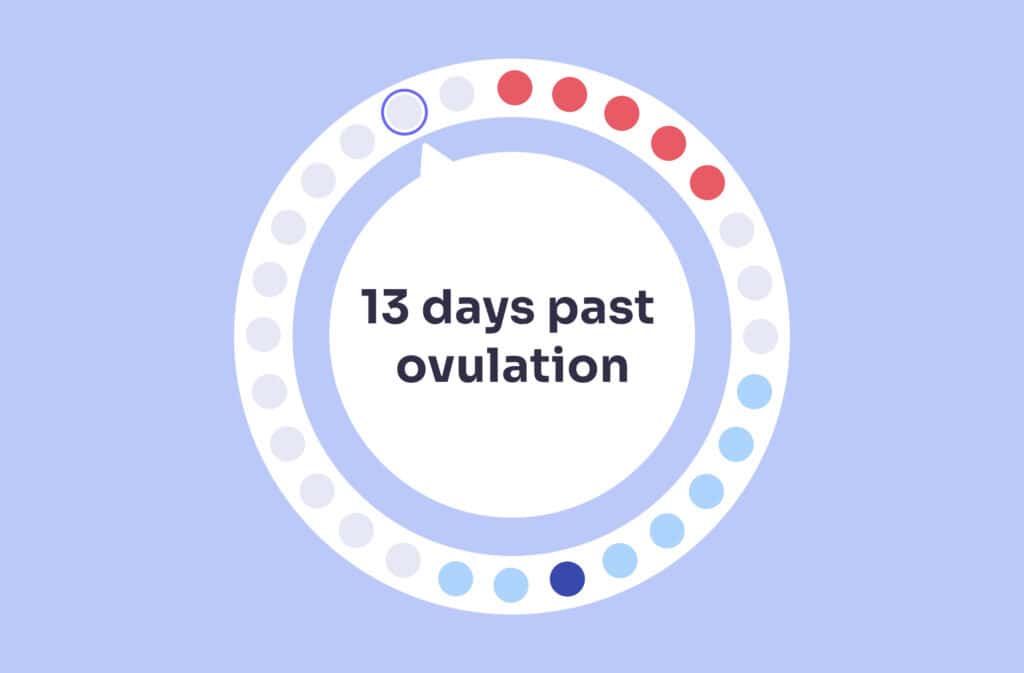
- Updated Feb 25, 2025
- Published
CRAFTED BY HUMAN
Crafted by human At Femia, we provide accurate and up-to-date information at every stage of your journey, from trying to conceive, pregnancy and postnatal support. All content is created by a real person based on in-depth research and own professional experience. Femia ensures that you will receive expert advice, strict accuracy and a personalized approach from our authors/medical experts. Learn more about our editorial policy.
FACT CHECKED
Fact checked At Femia Health, we maintain the highest standards of editorial excellence in delivering content focused on helping you conceive, guiding you through pregnancy, and supporting you postpartum. Explore our content review principles to learn how we ensure the accuracy and quality of our health and lifestyle tips for every stage of your journey.
At 13 DPO (13 days past ovulation):
- Implantation is complete if conception occurred.
- hCG levels are rising rapidly if pregnant, making most pregnancy tests reliable. You’re just a day away from your expected period if you have a 28-day cycle.
- Early pregnancy symptoms may be more noticeable for many women.
- 13 DPO symptoms can be quite similar to premenstrual symptoms, but may be more intense.
Welcome to 13 DPO! You’re now at a pivotal point where pregnancy can often be confirmed. Let’s explore the changes happening in your body and the signs you might be experiencing.
➡️ Read other Femia guides in this series:
- 1 DPO: What to expect, and how to tell if you’re pregnant
- 2 DPO: What to expect, and how to tell if you’re pregnant
- 3 DPO: What to expect, and how to tell if you’re pregnant
- 4 DPO: What to expect, and how to tell if you’re pregnant
- 5 DPO: What to expect, and how to tell if you’re pregnant
- 6 DPO: What to expect, and how to tell if you’re pregnant
- 7 DPO: What to expect, and how to tell if you’re pregnant
- 8 DPO: What to expect, and how to tell if you’re pregnant
- 9 DPO: What to expect, and how to tell if you’re pregnant
- 10 DPO: What to expect, and how to tell if you’re pregnant
- 11 DPO: What to expect, and how to tell if you’re pregnant
- 12 DPO: What to expect, and how to tell if you’re pregnant
- 14 DPO: What to expect, and how to tell if you’re pregnant
- 15 DPO: What to expect, and how to tell if you’re pregnant
- 16 DPO: What to expect, and how to tell if you’re pregnant
What does 13 DPO mean?
13 DPO stands for “13 days past ovulation.” You’re at the tail end of your luteal phase, just on the cusp of either starting a new cycle or continuing into early pregnancy.
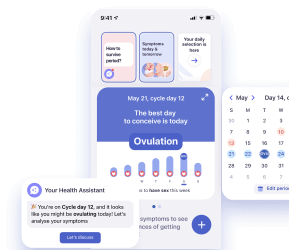
What's happening in your body at 13 DPO?
At 13 DPO, several key processes are occurring:
1. Hormone fluctuations
If you’re pregnant, your hCG levels are rising steadily. If not, estrogen and progesterone levels are dropping, preparing for menstruation.
2. Uterine changes
Your uterine lining remains thick, either supporting a developing embryo or preparing to shed if pregnancy hasn’t occurred.
3. Potential embryo development
If conception took place, the embryo is now firmly implanted and growing rapidly.
13 DPO symptoms: What might you be experiencing?
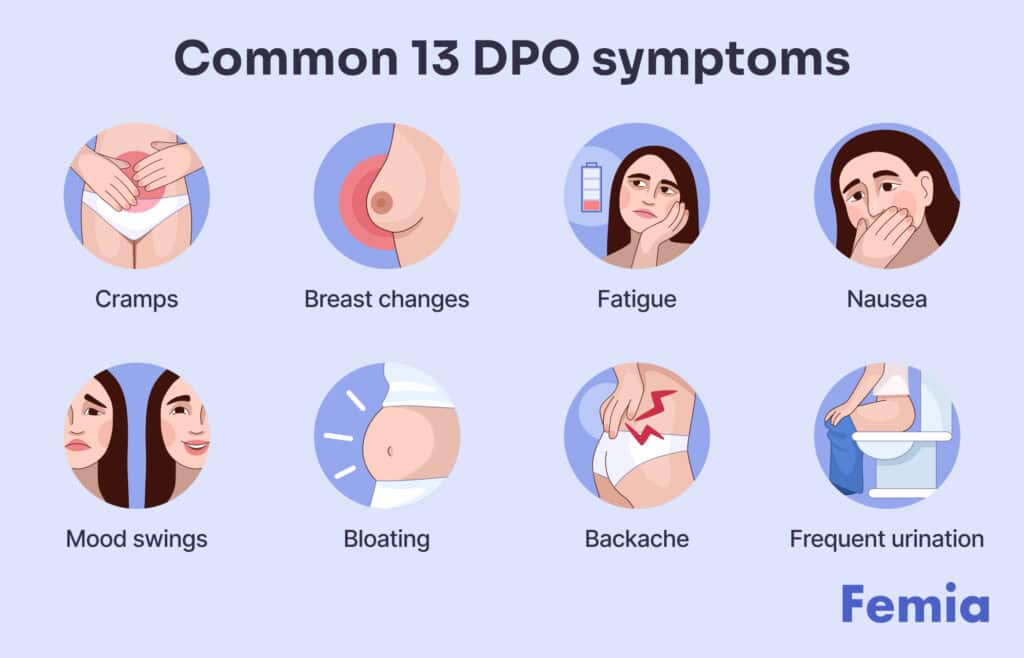
At 13 DPO, symptoms can be more pronounced. Here are some common experiences:
- Cramps: 13 DPO cramps can occur due to early pregnancy or impending menstruation.
- Breast changes: Increased tenderness, swelling, or darkening of the areolas.
- Fatigue: Feeling more tired than usual is common in early pregnancy.
- Nausea: Some women may start experiencing morning sickness.
- Mood swings: Hormonal changes can lead to emotional fluctuations.
- Bloating: You might feel puffy or bloated in your abdomen.
- Backache: 13 DPO cramps and backache can be early pregnancy signs or PMS symptoms.
- Frequent urination: You might find yourself visiting the bathroom more often.
13 DPO discharge if pregnant
At 13 DPO, pregnancy-related discharge often has these characteristics:
- Volume: Usually increased
- Consistency: Creamy or milky
- Color: Typically clear or white
- Odor: Mild or odorless
However, discharge can vary greatly among women and isn’t a definitive sign of pregnancy.
👉Find out more: Ultimate pre-pregnancy checklist: Essential steps to take before having a baby
13 DPO cervical mucus
Cervical mucus at 13 DPO can provide clues about your body’s state:
- If pregnant: Often creamy, abundant, and white or yellow in color
- If not pregnant: May become thicker or decrease as you approach your period
Remember, cervical mucus observations aren’t a reliable method to confirm or rule out pregnancy.
13 DPO symptoms leading to BFP
While every pregnancy is unique, some women who get a Big Fat Positive (BFP) report these symptoms at 13 DPO:
- Intense fatigue;
- Mild but persistent cramping;
- Noticeable breast changes;
- Heightened sense of smell;
- Nausea or food aversions;
- Mood swings;
- Frequent urination;
- Implantation bleeding or spotting.
13 DPO: Pregnancy vs. PMS symptoms
At 13 DPO, distinguishing between early pregnancy and PMS can be challenging. Here’s a comparison:
| Symptom | 13 DPO: pregnant | 13 DPO: PMS |
|---|---|---|
| Cramping | Often milder, may be intermittent | Usually more intense, like period cramps |
| Breast changes | Tenderness, possible darkening of areolas | Tenderness, typically resolves with period onset |
| Mood changes | Can be more pronounced and persistent | Often improves once period starts |
| Fatigue | May be more intense and ongoing | Usually improves after period starts |
| Nausea | Possible, may increase over time | Uncommon, but can occur |
| Backache | Can be present, often with lower abdominal discomfort | Common, often improves with period onset |
13 DPO implantation bleeding and spotting
Spotting at 13 DPO is less likely to be implantation bleeding, as implantation usually occurs earlier. However, some women may experience:
- Late implantation bleeding: Light spotting from delayed implantation
- Early signs of menstruation: Your period may be starting
- Pregnancy-related spotting: Light bleeding can occur in early pregnancy
If spotting is heavy or accompanied by pain, consult your healthcare provider.
with confidence

13 DPO hCG levels
At 13 DPO, hCG levels in pregnant women can vary widely:
- Average range is 15-100 mIU/mL.
- Some women see levels as high as 400 mIU/mL.
Remember, what’s most important is how your hCG levels change over time, not a single measurement.
👉Find out more: Evaporation line vs. faint positive: How to tell the difference on your pregnancy test
Questions from the Femia community
I've been experiencing intense food cravings at 13 DPO. Could this be a sign of pregnancy?
Food cravings can indeed be an early pregnancy symptom, but they can also occur during PMS. The key difference is often in the intensity and duration. Pregnancy cravings tend to be more specific and persistent. However, the only way to confirm pregnancy is through a test.
My 13 DPO pregnancy test showed a faint line. What does this mean?
A faint line on a pregnancy test at 13 DPO is often a positive result. hCG levels are just beginning to rise, which can result in a faint line. To confirm, try testing again in a day or two – the line should become darker if you're pregnant.
I'm feeling unusually emotional at 13 DPO. Is this normal?
Emotional changes are common at 13 DPO, whether you're pregnant or not. Hormonal fluctuations can cause mood swings, irritability, or heightened emotions. If you're pregnant, these feelings might persist or intensify. If not, they typically resolve once your period starts.
The bottom line
At 13 DPO, you’re at a point where pregnancy can often be confirmed through home tests. While symptoms can provide clues, they’re not definitive. If you’re trying to conceive, this can be an emotionally charged time. Remember to be kind to yourself, regardless of the outcome.
If you have concerns about your symptoms or cycle, don’t hesitate to reach out to a healthcare professional. They can provide personalized advice and support as you navigate this phase of your journey.
➡️ Read other Femia guides in this series:
- 1 DPO: What to expect, and how to tell if you’re pregnant
- 2 DPO: What to expect, and how to tell if you’re pregnant
- 3 DPO: What to expect, and how to tell if you’re pregnant
- 4 DPO: What to expect, and how to tell if you’re pregnant
- 5 DPO: What to expect, and how to tell if you’re pregnant
- 6 DPO: What to expect, and how to tell if you’re pregnant
- 7 DPO: What to expect, and how to tell if you’re pregnant
- 8 DPO: What to expect, and how to tell if you’re pregnant
- 9 DPO: What to expect, and how to tell if you’re pregnant
- 10 DPO: What to expect, and how to tell if you’re pregnant
- 11 DPO: What to expect, and how to tell if you’re pregnant
- 12 DPO: What to expect, and how to tell if you’re pregnant
- 14 DPO: What to expect, and how to tell if you’re pregnant
- 15 DPO: What to expect, and how to tell if you’re pregnant
- 16 DPO: What to expect, and how to tell if you’re pregnant
References
- American College of Obstetricians and Gynecologists (ACOG). “Early Pregnancy Loss: Miscarriage and Molar Pregnancy.” ACOG Practice Bulletin, no. 200, 2018, pp. 1-10. The American College of Obstetricians and Gynecologists. https://www.acog.org/clinical/clinical-guidance/practice-bulletin/articles/2018/11/early-pregnancy-loss.
- “Luteal Phase, an overview.” ScienceSirect. https://www.sciencedirect.com/topics/medicine-and-dentistry/luteal-phase.
- Sapra, Katherine J., et al. “Signs and Symptoms Associated With Early Pregnancy Loss: Findings From a Population-Based Preconception Cohort.” Human Reproduction, vol. 31, no. 4, 2016, pp. 887-896. https://www.researchgate.net/publication/296682402_Signs_and_symptoms_associated_with_early_pregnancy_loss_Findings_from_a_population-based_preconception_cohort.
- National Institutes of Health. “What are some common signs of pregnancy?” National Institute of Child Health and Human Development, 2017. https://www.nichd.nih.gov/health/topics/pregnancy/conditioninfo/signs.
- Mayo Clinic Staff. “Home pregnancy tests: Can you trust the results?” Mayo Clinic, 2022. https://www.mayoclinic.org/healthy-lifestyle/getting-pregnant/in-depth/home-pregnancy-tests/art-20047940.
- U.S. Food and Drug Administration. “Pregnancy.” FDA, 2019. https://www.fda.gov/medical-devices/home-use-tests/pregnancy.
- Johnson, Sarah R., et al. “Levels of Urinary Human Chorionic Gonadotrophin (hCG) Following Conception and Variability of Menstrual Cycle Length in a Cohort of Women Attempting to Conceive.” Current Medical Research and Opinion, vol. 25, no. 3, 2009, pp. 741-748. https://pubmed.ncbi.nlm.nih.gov/19196217/.
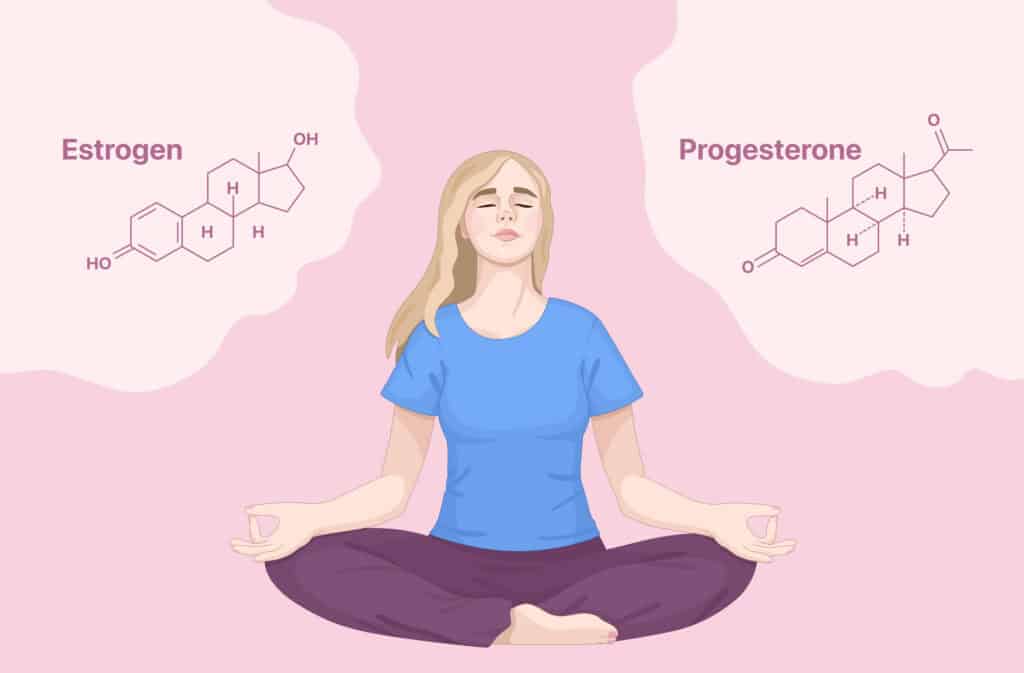
Let’s learn how two key female hormones – progesterone and estrogen – differ, how they affect different functions, and why they matter.
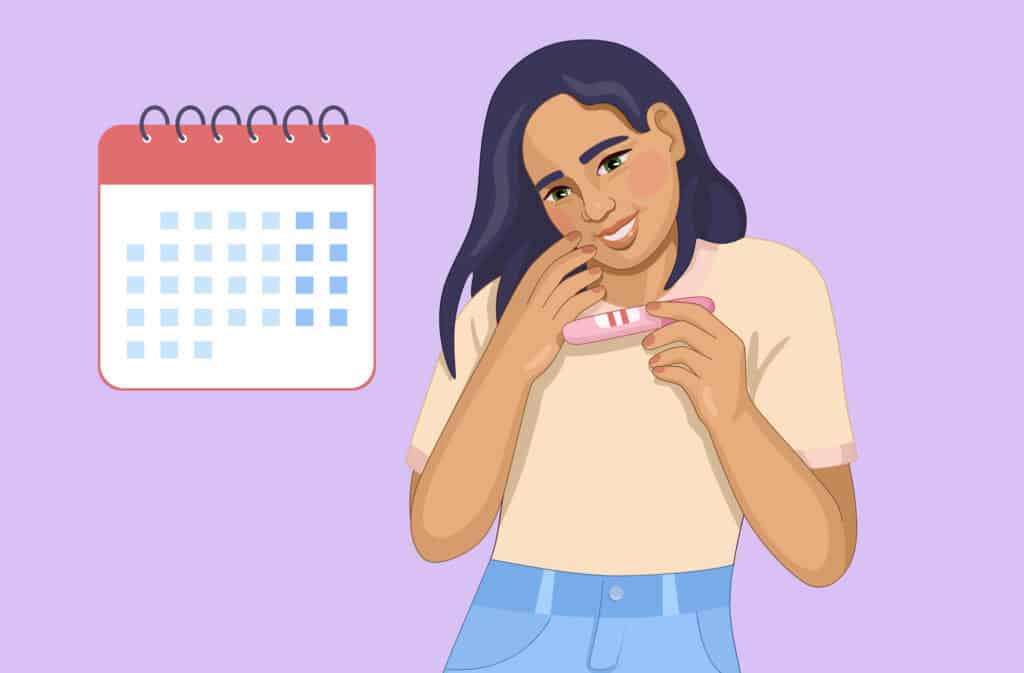
What is your chance of pregnancy by age? Fertility decreases as the years go by. Take a look at various female fertility age charts and learn how to maximize yours.
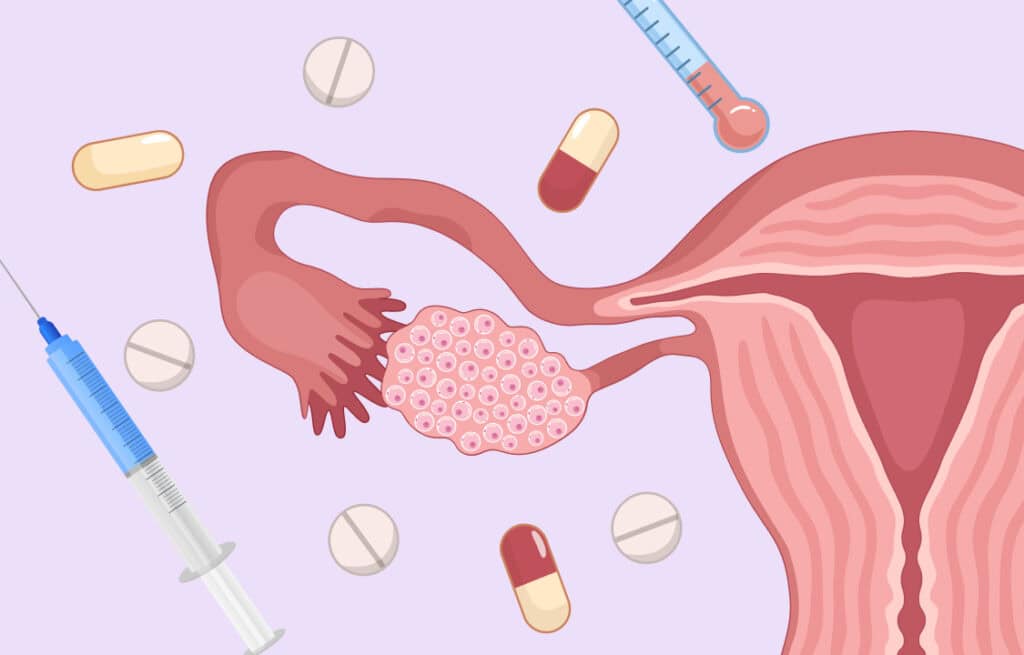
Let’s learn what OHSS means, its mild and severe symptoms, medical and self-care treatment options.

